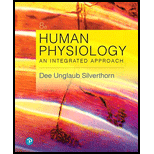
Concept explainers
(a)
To determine: The tissue that has the highest blood flow per unit weight.
Introduction: The body contains a well-defined system to transport vital components across the body. This organ system is called the circulatory system. The circulatory system contains a fluid called blood that carries all the important gases and nutrients.
(b)
To determine: The tissue that has the least blood flow regardless of weight.
Introduction: The blood vessels carry blood and transport it to all the parts of the body. The rate of blood flow varies in all the blood vessels. Different tissues have a different rate of blood flow. Some have a very high rate of blood flow while some have a low rate of blood flow.
Want to see the full answer?
Check out a sample textbook solution
Chapter 15 Solutions
Human Physiology: An Integrated Approach (8th Edition)
- Increasing the volume of the plasma would function to (A) increase blood viscosity (B) decrease blood viscosityarrow_forwardFastyarrow_forwardPlasma contributes approximately ________________percent of the volume of whole blood, and water accounts for _____________________ percent of the plasma volume. (a) 55, 92 (c) 92, 55 (b) 25, 55 (d) 35, 72.arrow_forward
- Answer each question with a type of blood vessel: [1] artery; [2] vein; [3] capillary. (a) Which type of blood vessel carries blood from the tissues to the heart? (b) Which type carries blood that is rich in oxygen? (c) Which type contains a thin cell wall that allows the passage of water and small molecules?arrow_forwardThe aorta is the principal blood vessel through which blood leaves the heart in order to circulate around the body. (a) Calculate the average speed of the blood in the aorta if the flow rate is 5.0 L/min. The aorta has a radius of 10 mm. (b) Blood also flows through smaller blood vessels known as capillaries. When the rate of blood flow in the aorta is 5.0 L/min, the speed of blood in the capillaries is about 0.33 mm/s. Given that the average diameter of a capillary is 8.0 μm (1 μm = 1 X 10 –6 m), calculate the number of capillaries in the blood circulatory system.arrow_forwardA general principle of physiology states that information flow between cells, tissues, and organs is an essential feature of homeostasis and allows for integration of physiological processes. How is this principle demonstrated by the relationship between the circulatory and endocrine systems?arrow_forward
- Local control of blood flow through a tissue a) maintains a blood flow independent of changes in blood pressure b) is controlled via a relaxation or contraction of precapillary sphincters c) is controlled by changes in oxygen levels in the tissue d) is controlled by changes in carbon dioxide levels in the tissuearrow_forward(a) Name the type of blood vessel labelled (i) C. (ii) D. (b) In which direction does blood in vessel A travel? (c) Which of the four blood vessels contains the most oxygen? (d) What happens to the amount of oxygen in the blood as it passes through the body organs? (e) What is the chamber of the heart labelled X? ·arrow_forwardActivation of the vascular endothelium is an important event associated with cardiovascular diseases. Explain why. (minimum 60 words)arrow_forward
- Differentiate the three major blood vessels according to: A. TUNICS B. Blood that flows within each blood vessel (color, viscosity, pH, and specific gravity) C. The method of extraction in each blood vesselarrow_forwardA blood cell drifts along with the flow of blood through an artery that has a section partially blocked by fatty deposits on the artery wall.As the blood cell moves from the wide region of the artery into the narrow region (with the wall deposits), it experiences... *arrow_forwardCompared with the interstitial fluid that bathes active muscle cells, blood reaching these cells in arteries has a(A) lower osmotic pressure.(B) higher PO2.(C) lower pH.(D) higher PCO2.(E) greater bicarbonate concentration.arrow_forward
 Human Physiology: From Cells to Systems (MindTap ...BiologyISBN:9781285866932Author:Lauralee SherwoodPublisher:Cengage Learning
Human Physiology: From Cells to Systems (MindTap ...BiologyISBN:9781285866932Author:Lauralee SherwoodPublisher:Cengage Learning Human Biology (MindTap Course List)BiologyISBN:9781305112100Author:Cecie Starr, Beverly McMillanPublisher:Cengage Learning
Human Biology (MindTap Course List)BiologyISBN:9781305112100Author:Cecie Starr, Beverly McMillanPublisher:Cengage Learning


